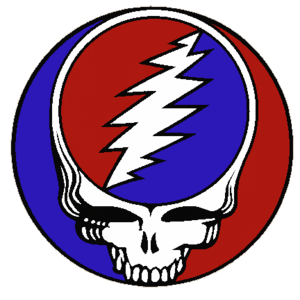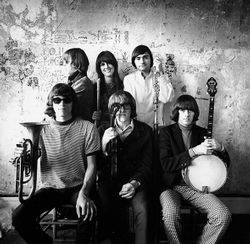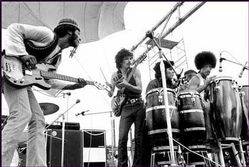The San Francisco Sound


The San Francisco Sound refers to rock music performed live and recorded by San Francisco-based rock groups of the mid 1960s to early 1970s.
It was associated with the counterculture community in San Francisco during these years.
Prominent in this development were groups such as the Vejtables, the Beau Brummels, Venus Flytrap, Fifty Foot Hose, Jefferson Airplane, the Grateful Dead, David LaFlamme Band, Janis & Big Brother & the Holding Company, and Quicksilver Messenger Service – and later the Steve Miller Blues Band, Santana, Moby Grape, Blue Cheer, Uther Pendragon, Tripsicord (Music Box), Fritz, Lee Michaels and the Loading Zone.
Many bands formed, and each band had its characteristic sound, but enough commonalities existed that there was a regional identity, too. By 1966, fresh and adventurous improvisation during live performance (which many heard as being epitomized by the Grateful Dead) was one characteristic of the San Francisco Sound.
A louder, more prominent role for the electric bass – typically with a melodic or semi-melodic approach, and using a plush, pervasive tone — was another feature.
This questing bass quality has been wryly characterized as a "roving" (rather than the conventional "stay-at-home") style.
Exploration of chordal progressions previously uncommon in rock & roll, and a freer and more resourceful use of all instruments (drums and other percussion, electric guitars, keyboards, as well as the bass) went along with this "psychedelic-era" music. Trumpets and saxophones were rarely used, unlike in contemporary R&B and soul bands and some of the white bands from the U.S. East Coast (e.g., Blood, Sweat & Tears or Chicago).
(Sly & the Family Stone, a San Francisco-based group that got its start in the late '60s, was an exception, being a racially integrated hippie band with a hefty influence from soul music, hence making use of brass instrumentation.)
This was the period when "rock" was differentiating itself from "rock & roll," partly due to the upshot of the British Invasion.
In San Francisco, musical influences came in from not only London and Liverpool, but also the American bi-coastal folk-music revival scene of the 1950s and 1960s, the Chicago electric blues scene, the soul music scenes in Detroit, Memphis, and Muscle Shoals, jazz styles of various eras and regions, and more.
The lyrical content of the San Francisco Sound was both emotional (which carried over from early rock & roll) and intelligent, reflecting the influence of such pioneering contemporary lyricists as Bob Dylan and John Lennon.
Lyrics were deliberately, and often skillfully, poetic.
In this respect for poetry, the San-Francisco-Sound writers were no doubt also influenced by the Beat Generation poets of the San Francisco Renaissance of a decade before (and, incidentally, Beat writers like Jack Kerouac and Gary Snyder had already served to influence people like Dylan).
The quest for peaceful good times, for love, empathy, brotherhood, and solidarity, for increased wisdom, for harmony with nature, and for personal and collective fulfillment was represented in lyrics.
Typically, a San Francisco band's live performance included at least a few musical jams, displaying a spirit simiar to jazz.
On these numbers, the musicians took the audience along on an exciting journey.
The San Francisco bands' music was everything that AM-radio pop music wasn't.
Their performances contrasted with the "standard three-minute track" that had become a cliché of the pop-music industry, due to the requirements of AM radio (and to the limited potentials of many pop songs and song treatments).
The San Francisco bands would often show their improvisatory zest by playing a given song or instrumental for, say, five to thirty minutes (and sometimes for longer).
The music was loud and community-connected: bands sometimes presented free concerts in Golden Gate Park and "happenings" at the city's several psychedelic clubs and ballrooms.
Because San Francisco had an especially vibrant and attractive countercultural scene in the late half of the 1960s, musicians from elsewhere (along with the famous hip multitude) came there. Some stayed and became part of the scene.
An example would be the Sir Douglas Quintet, whose music took on more of the character of the San Francisco Sound, while yet retaining some of its original Texas flavor.
The San Francisco Sound was widely influential during its heyday and since.
Source:Wikipedia
http://en.wikipedia.org/wiki/San_Francisco_Sound
>>>>>>>>>>>>>>>>>>>>>>>>>>>>>>>>>>>>>>>>>>>>>>>>>>>>>>>
I once saw "The Jefferson Airplane" (pre-"Starship" dayzin the late Sixties) take the stage at about nine P.M. and played/Jammed until around 3 A.M. ...
... ~Really Grandpa?~

It was well worth the three dollars for a ticket and one of the best times I can barely remember.
I should go ask Alice, I think she'll know.



It's pretty clear now that what looked like it might have been some kind of counterculture is, in reality, just the plain old chaos of undifferentiated weirdness. -Jerry Garcia-
The quest for peaceful good times, for love, empathy, brotherhood, and solidarity, for increased wisdom, for harmony with nature, and for personal and collective fulfillment was represented in lyrics.


The San Francisco Sound refers to rock music performed live and recorded by San Francisco-based rock groups of the mid 1960s to early 1970s.
It was associated with the counterculture community in San Francisco during these years.
Prominent in this development were groups such as the Vejtables, the Beau Brummels, Venus Flytrap, Fifty Foot Hose, Jefferson Airplane, the Grateful Dead, David LaFlamme Band, Janis & Big Brother & the Holding Company, and Quicksilver Messenger Service – and later the Steve Miller Blues Band, Santana, Moby Grape, Blue Cheer, Uther Pendragon, Tripsicord (Music Box), Fritz, Lee Michaels and the Loading Zone.
Many bands formed, and each band had its characteristic sound, but enough commonalities existed that there was a regional identity, too. By 1966, fresh and adventurous improvisation during live performance (which many heard as being epitomized by the Grateful Dead) was one characteristic of the San Francisco Sound.
A louder, more prominent role for the electric bass – typically with a melodic or semi-melodic approach, and using a plush, pervasive tone — was another feature.
This questing bass quality has been wryly characterized as a "roving" (rather than the conventional "stay-at-home") style.
Exploration of chordal progressions previously uncommon in rock & roll, and a freer and more resourceful use of all instruments (drums and other percussion, electric guitars, keyboards, as well as the bass) went along with this "psychedelic-era" music. Trumpets and saxophones were rarely used, unlike in contemporary R&B and soul bands and some of the white bands from the U.S. East Coast (e.g., Blood, Sweat & Tears or Chicago).
(Sly & the Family Stone, a San Francisco-based group that got its start in the late '60s, was an exception, being a racially integrated hippie band with a hefty influence from soul music, hence making use of brass instrumentation.)
This was the period when "rock" was differentiating itself from "rock & roll," partly due to the upshot of the British Invasion.
In San Francisco, musical influences came in from not only London and Liverpool, but also the American bi-coastal folk-music revival scene of the 1950s and 1960s, the Chicago electric blues scene, the soul music scenes in Detroit, Memphis, and Muscle Shoals, jazz styles of various eras and regions, and more.
The lyrical content of the San Francisco Sound was both emotional (which carried over from early rock & roll) and intelligent, reflecting the influence of such pioneering contemporary lyricists as Bob Dylan and John Lennon.
Lyrics were deliberately, and often skillfully, poetic.
In this respect for poetry, the San-Francisco-Sound writers were no doubt also influenced by the Beat Generation poets of the San Francisco Renaissance of a decade before (and, incidentally, Beat writers like Jack Kerouac and Gary Snyder had already served to influence people like Dylan).
The quest for peaceful good times, for love, empathy, brotherhood, and solidarity, for increased wisdom, for harmony with nature, and for personal and collective fulfillment was represented in lyrics.
Typically, a San Francisco band's live performance included at least a few musical jams, displaying a spirit simiar to jazz.
On these numbers, the musicians took the audience along on an exciting journey.
The San Francisco bands' music was everything that AM-radio pop music wasn't.
Their performances contrasted with the "standard three-minute track" that had become a cliché of the pop-music industry, due to the requirements of AM radio (and to the limited potentials of many pop songs and song treatments).
The San Francisco bands would often show their improvisatory zest by playing a given song or instrumental for, say, five to thirty minutes (and sometimes for longer).
The music was loud and community-connected: bands sometimes presented free concerts in Golden Gate Park and "happenings" at the city's several psychedelic clubs and ballrooms.
Because San Francisco had an especially vibrant and attractive countercultural scene in the late half of the 1960s, musicians from elsewhere (along with the famous hip multitude) came there. Some stayed and became part of the scene.
An example would be the Sir Douglas Quintet, whose music took on more of the character of the San Francisco Sound, while yet retaining some of its original Texas flavor.
The San Francisco Sound was widely influential during its heyday and since.
Source:Wikipedia
http://en.wikipedia.org/wiki/San_Francisco_Sound
>>>>>>>>>>>>>>>>>>>>>>>>>>>>>>>>>>>>>>>>>>>>>>>>>>>>>>>
I once saw "The Jefferson Airplane" (pre-"Starship" dayzin the late Sixties) take the stage at about nine P.M. and played/Jammed until around 3 A.M. ...
... ~Really Grandpa?~
It was well worth the three dollars for a ticket and one of the best times I can barely remember.
I should go ask Alice, I think she'll know.


It's pretty clear now that what looked like it might have been some kind of counterculture is, in reality, just the plain old chaos of undifferentiated weirdness. -Jerry Garcia-

Last edited:


